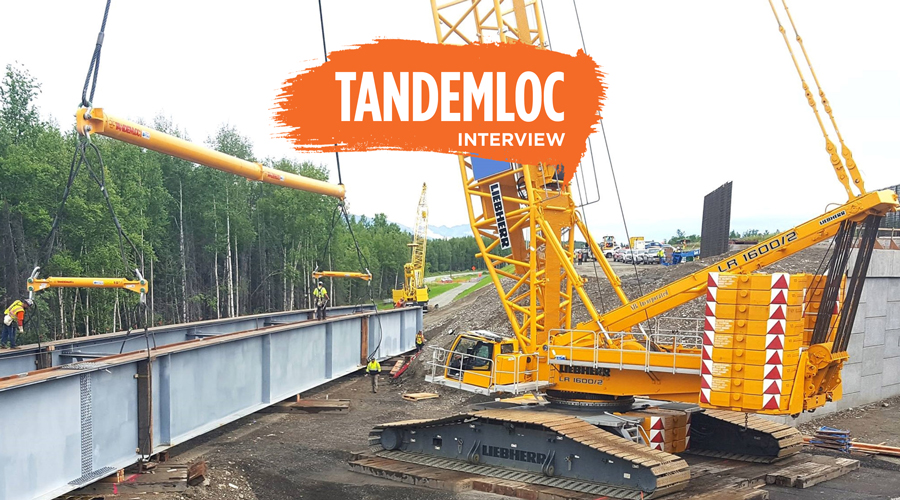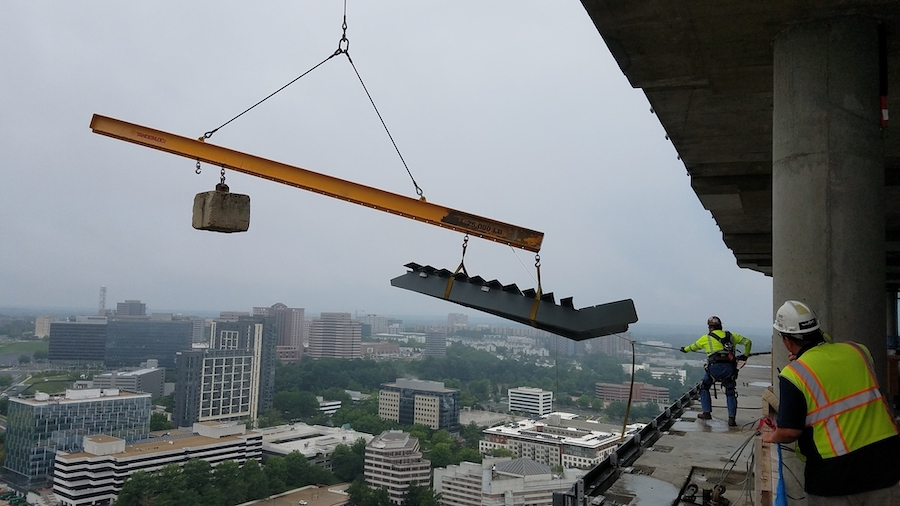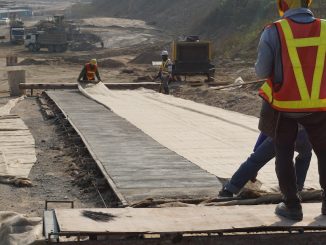
E&C’s interview with Tandemloc, who has designed and manufactured lifting and rigging products for over thirty years and is determined to build the safest and most effective lifting, securing, and mobilizing equipment possible.
E&C: Tandemloc has an impressive line-up of spreader beams. Which would you say are your most popular models and applications?
TL: By far our most popular model spreader beam is the “AT14” Series Spreader Beam. The beams are sold with or without the top rigging (buyer’s choice) and come in a large range of capacities and spans. The AT14 spreader beams are telescopic and offer a quick pin release at 6″ or 12″ increments between the minimum and maximum span. Our most commonly sold size is the 12′-20′ span with a rated capacity of 50,000lbs at each of the incremental adjustment lengths. We market various sizes, ranging from 2,000lbs to over 100,000lbs capacities, with over 40+ different spreader beams in stock, on the shelf, ready for shipment to domestic and international locations. Should a customer require a size that is not stocked, our turnaround time is quick as we keep the various components pre-fabricated and ready to be assembled quickly.
Another spreader beam product line that is worth mentioning is our Rapid Ready™ Custom Spreader Beams. With capacities up to 100,000lbs at maximum 40ft spreads, these fixed spreader beams are shipped within 5 to 7 work days from order acknowledgement. Our customers enjoy a custom spreader beam suited to their application’s specifications without the hassle and time waste of a typical “custom” product. The Rapid Ready™ Spreader Beams are fixed and accommodate appropriately sized top rigging, which can be purchased with the spreader beam as an assembly that is ready to lift.
It is important to note, unlike many in the Below-the-Hook Lifting Industry, we at Tandemloc individually proof test all of our lifting equipment to the recommended industry test rating on our patented test stand. The tests are videotaped, time-stamped, and unable to be edited. Each beam includes the serialized proof test certificate and customers may purchase a video of the test if they so desire.
Our spreader beams are used across various industry types: construction, roads and bridges (infrastructure), aerospace, maritime, military, etc. Our focus, and that of our customers’, is to assist in facilitating a safe lift — regardless of industry and application.
E&C: For our readers who are unaware, can you explain the difference between a spreader beam and lifting beam?
TL: Simply put, a spreader is designed to carry only compression loads between the lift points while a lift beam is designed to carry shear and bending moments between the lift points. Spreaders are typically lighter in weight than a comparable lift beam, but they will require a top lift sling which greatly impacts the overall distance between the crane hook and the load. Lift beams will usually be heavier, but do not require any top slings as the crane can connect directly to the lifter. This tends to make lift beams easier to handle and set up. Many times, it makes economic sense to have a combination of lift beam and spreader capabilities in the same product. Ultimately deciding which solution is right for your lift is a matter of headroom, crane capacity, and cost.
E&C: Are there advantages to using a spreader beam over a lifting beam?
TL: Spreader beams can offer several advantages. Not only are they often lighter and cheaper than their lift beam counterparts, but they can easily be made in a telescopic format which allows for several spans to be obtained from a single lifter. Lift beams can be telescopic as well, but dealing with the bending stress makes it a bit more costly. Another advantage a spreader beam can offer over a lift beam is demonstrated in Tandemloc’s line of spreader beam end caps. Because the only loads being handled by the spreader beam are compression loads, the entire span can be made up of interchangeable components with simple pinned connections. This makes spreader beams a great choice for customers who need versatility and don’t mind having a top sling that could be as tall as 50% of the span or more. It is worth noting that all this height does add to the stability of the lift since the center of gravity tends to be well below the crane hook.

E&C: What factors determine the use of a spreader beam and lifting beam?
TL: Many times, it comes down to the priorities of the lift. Lift beams are often more expensive and heavier, but they can be easier to use since they connect directly to the load and crane with little or no rigging required. Again, headroom is a factor. But where that load needs support is crucial. If the load has more than two pick points, or it needs support along its length, then a lift beam is the only choice. Sometimes the load requires two cranes to lift at a single pick point on the load. This is something a lift beam can handle with ease, but it’s a huge risk for a spreader beam since both cranes would have to move in perfect harmony throughout the lift to maintain the spreader geometry.
E&C: Based on your 30+ years of experience with spreader beams, do you notice any common mistakes during usage? Do you have any general advice for their application?
TL: Every below-the-hook product that we sell has been proof-tested and we aren’t aware of anyone else with level of testing capability we have here at Tandemloc. We take great pride in the confidence our customer’s place in our patented proof testing equipment, but they must remain aware of the rugged environment lifting products can often find themselves in. Many of our customers have their own well-documented maintenance and inspection procedures and some customers choose to send products back to us for expert re-certification and inspection. Even still, we have seen lifters and rigging that get neglected or abused to the point that it becomes a safety issue. There are very specific ways to inspect things like wire rope slings and other rigging that the average person may not be trained in, but these inspections are crucial to maintaining the original factor of safety the components had when they were new. In every case, the end user should periodically inspect for things like damage, corrosion, loose or missing components, worn or illegible decals or safety labels and signs of misuse. Most lifting devices are designed with static loading in mind, so shock loading or abrupt changes in the magnitude or direction of loads should never take place. Low height test lifts should always be performed to ensure that the load remains level once it is off the ground. The environment in which the lifter is to be used needs to be considered during the design of the lifter as well. If the lifter is to be used in extreme heat or cold, or perhaps underwater, the lifter may need to be specially designed for that environment. Last but not least, never exceed the working load limit of any piece of lifting equipment and be sure that all loads are known and accounted for. Obviously, gross overloading or improper loading can pose an immediate safety risk, but the damage caused by less extreme overloading or improper loading could be invisible to the naked eye, but the fatigue life of the overloaded components may have greatly decreased. Tandemloc does rigorously test our equipment using our patent Load Test System for loads up to 300 tons. But there are several other pieces of equipment involved in a lift — slings, hooks, etc. So, taking the time to do a careful inspection of the load and all the lifting equipment before the lift is critical.
E&C: Would you like to highlight any other products?
TL: We have heavy-duty concrete barrier grabs that can be operated remotely with our Tandemloc Autolatch™ mechanism. The AS23B00-083-PA can handle up to 4.125 tons (8,250 pounds). The AS23B00-165-PA offers double the capacity — 8.25 tons (16,500 pounds). Options for our concrete barrier grabs include an adjustable handle, alignment guide, and replacement pads.
I also want to mention that we can custom build equipment to a client’s specifications.
E&C: What else should we know about Tandemloc?
TL: For over 30 years Tandemloc has engineered and manufactured below-the-hook lifting equipment and container lifting, securing, and mobilizing equipment for thousands of standard and custom applications. At Tandemloc, quality and safety are our number one priority — both for our employees and our customers. All of our lifting equipment has been designed, manufactured, and tested to meet or exceed the current Below-the-Hook Lifting Industry’s stringent safety standards. We value the human lives that operate our products and have taken the extra steps necessary to ensure that our equipment is not just top-notch, but also without critical error. It is our mission to operate in a manner that is at our very best, so we may continue to provide employment for our community and safe quality products for our customers in accordance with the words found in Colossians 3:23, “Whatever you do, work at it with all your heart, as working for the Lord…”.













































